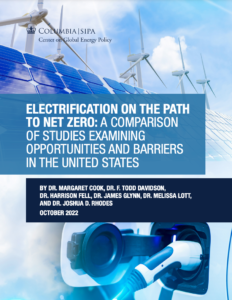Full Title: Electrification on the Path to Net Zero: A Comparison of Studies Examining Opportunities and Barriers in the United States
Author(s): Dr. Margaret Cook, Dr. F. Todd Davidson, Dr. Harrison Fell, Dr. James Glynn, Dr. Melissa Lott, and Dr. Joshua D. Rhodes
Publisher(s): Columbia SIPA Center on Global Energy Policy
Publication Date: October 15, 2022
Full Text: Download Resource
Description (excerpt):
There is a strong and growing consensus that a simultaneously growing and decarbonizing electricity sector is necessary to meet declining greenhouse gas emissions targets. Rallying cries to “electrify everything” have captured the focus of many headlines and policy forums in recent years. However, there are important questions that remain unanswered about the electrify everything movement, including the technical, social, and political feasibility of the approach, as well as the affordability and equitability of implementation. While reducing emissions is paramount in mitigating the negative impacts of the energy system to the environment and human health, it is also critical that changes to energy infrastructure are both socially and politically acceptable, as well as affordable to help ensure an economically vibrant future. These nuanced dynamics are not easily articulated in public forums regarding the goal to electrify everything. A more detailed assessment of the problem might discover a better path forward.
This report, part of the Power Sector and Renewables Research Initiative and Energy Systems Modeling Analytics program at Columbia University’s Center on Global Energy Policy, in conjunction with IdeaSmiths, examines eight recent major US studies on the topic. Six of the studies focus on strategies and pathways to a net-zero energy system and two assess the value of electrification and expanded transmission networks. This work serves to compare their assumptions and results. The authors’ purpose in analyzing the studies was threefold. First, the report explores the degrees of electrification in the United States that might be needed to achieve net-zero pathways as well as where and how electrification could occur under model assumptions. Second, it examines the relative roles of variable generation resources (e.g., wind and solar), energy storage (both short- and long-duration), and firm low-carbon power (e.g., natural gas with carbon capture, nuclear, hydro, and geothermal) in the energy transition to meet increasing levels of clean electricity demand. Finally, the report examines the barriers that could hinder both increased electrification and decarbonization of the pivotal power sector.
